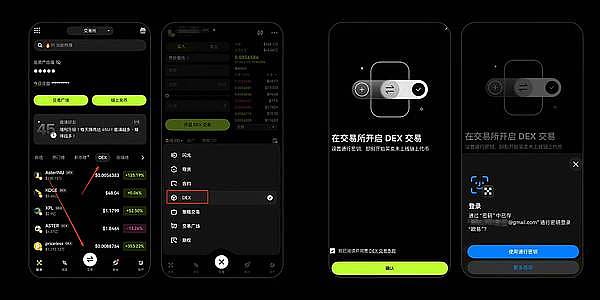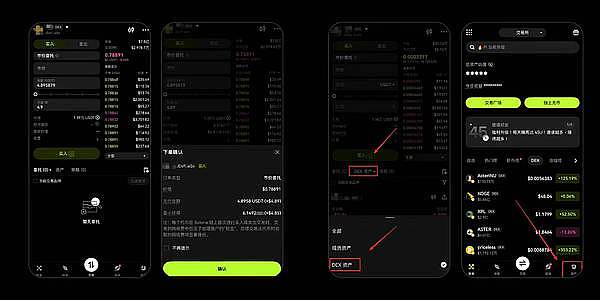Author: ChandlerZ, Foresight News
In the narrative of crypto trading, centralized vs. decentralized was once a clear-cut binary opposition, one side winning with depth and speed, the other with transparency and self-custody as its core beliefs.
Now, the boundaries are being redrawn. Leading exchanges no longer view on-chain trading as external traffic, but are attempting to directly integrate DEXs into the unified trading portal of CEXs, fusing matching, clearing and settlement, and the self-custody experience into one.
OKX has opened its in-exchange DEX product to all users, and currently offers gas-free access for a limited time. This is one of the rare systematic implementations in this direction. Since its finalization in the middle of the year, the project has involved cross-team collaboration of over 100 people, emphasizing product delivery under the dual constraints of regulatory compliance and user experience, and is seen as an important milestone for centralized platforms to proactively embrace the on-chain ecosystem.
Its goal is to find a stable balance between regulatory compliance, self-custody security, and user experience. As Lei Ming, head of the DEX within the OKX exchange, stated in an interview with Foresight News: "We hope users can complete on-chain transactions directly within OKX, but their assets remain firmly in their own hands." When DEXs are no longer just a "long tail," changes in market structure have provided a realistic impetus for integrating DEXs into exchanges. In June 2025, the global DEX/CEX spot trading volume ratio rose to a historical high of 27.9%; in the same month, the DEX/CEX trading volume ratio on the derivatives side also reached a new high of 8%. Both point to a trend: on-chain trading is no longer just a long tail, but is continuously eroding the centralized market share in the two core trading scenarios of spot and perpetual bonds. Behind this trend are the improvement of public chain performance, the maturity of liquidity aggregation technology, and the increasing demand from users for on-chain transparency. Market forces are changing the narrative. With the maturation of high-performance chains like Base and Solana, DEXs have transformed from being perceived as "slow, expensive, and with high slippage" to offering a "fast and deep" option. Matching/re-aggregating DEX technologies are bringing the traditional pain points of slippage and transaction certainty closer to the threshold of CEX experience. In reality, users don't care whether they trade "on-chain" or "off-chain"; they care more about the smoothness of the experience, the fairness of the price, and the security of their assets. From a regulatory perspective, the EU's MiCA has been refining its rules in stages since 2024, with stablecoin and service provider frameworks gradually being implemented. In the US, the Senate passed the GENIUS Act in June 2025, establishing federal-level baselines for reserves and disclosure. U.S. Securities and Exchange Commission (SEC) Chairman Paul Atkins has announced the launch of the SEC's "Project Crypto," a comprehensive overhaul of the existing regulatory system to accommodate crypto assets and pave the way for the "on-chain" transformation of the U.S. financial market. Atkins also stated his strong support for self-custodial wallets and his intention to reform the Special Purpose Brokerage (SPB) rules, which are not applicable to crypto assets, to develop more suitable regulations for registered institutions to hold crypto assets. These rules neither outright exclude DeFi nor discourage leading platforms from exploring productized forms of self-custodial trading gateways within compliance boundaries. As a result, exchanges have begun to realize that future incremental users may come from those middleware who want both visible assets and fast trading. OKX's choice is a response to this structural change. "Users are no longer discovering coins by looking at the exchange, but by looking at the on-chain activity," Lei Ming frankly stated. "What we want to do is merge the discovery and trading of on-chain assets into a continuous experience." This means that OKX is no longer just a platform for listing coins, but an entry point for on-chain transactions. Building on its accumulated capabilities in unified account systems, matching engines, and aggregators, the team began to try to make on-chain trading a part of the exchange experience. "This is not about stuffing DEX external chains into the app, but about integrating the experience at the product level." OKX's product logic: making self-custody a first-class citizen of the exchange. In this context, OKX's strategy is not "adding a DEX button to the app," but rather embedding on-chain trading as a system-level capability into the entire trading experience.


Its core choice is "self-custody first". For all assets not listed on exchanges, transactions must be initiated in the user's wallet and executed on-chain. The platform does not hold or custody assets. This means that OKX has proactively sacrificed some convenience in its product design in exchange for clear compliance and risk boundaries.
 YouQuan
YouQuan
 YouQuan
YouQuan Hui Xin
Hui Xin Joy
Joy YouQuan
YouQuan Brian
Brian Hui Xin
Hui Xin Joy
Joy Brian
Brian Hui Xin
Hui Xin YouQuan
YouQuan